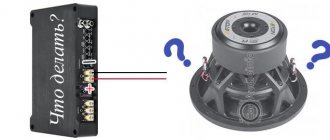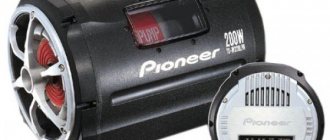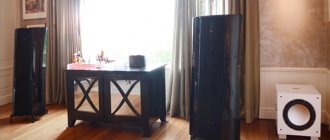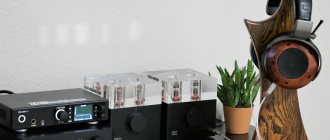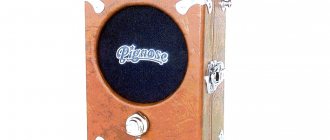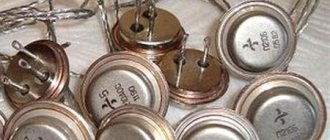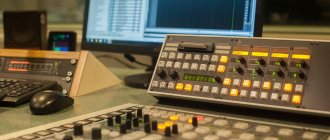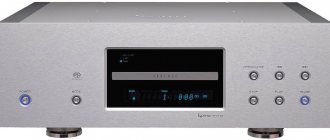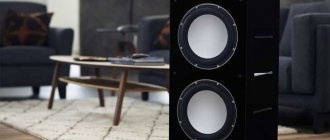As we understand, you are not looking for easy ways. And as you know, behind great work and effort lies the most valuable reward. Everyone hears music differently. It plays in our heads, and we try in every possible way to realize it in reality. But how to do that? Store windows are filled with an abundance of subwoofer speakers, but it’s impossible to listen to every one.
In this article we will tell you in detail how to choose a speaker for a subwoofer. What to pay attention to so that it plays exactly the way you want.
What is a subwoofer speaker and why is it better than factory subwoofers?
A subwoofer speaker is a type of acoustics designed to reproduce low frequencies. Unfortunately, the speaker simply won't play; it needs to be installed in a box. As a result, we will get a full-fledged subwoofer. Depending on the type of box, the sound of the subwoofer will change.
Why buy a speaker separately when we can buy a complete set? For example, a passive subwoofer from a well-known brand or a ready-made solution like an active subwoofer.
The answer to this question is actually simple - these are mass-produced subwoofers. Which use budget materials. For example, the thin walls of the box cause resonance, which is why the subwoofer plays quieter. And the components themselves do not inspire much confidence.
In our case, we choose a speaker that is best suited for certain musical preferences and tasks. We will make the correct calculations for it, and make a box from high-quality durable materials. As a result, we will get a result that factory subwoofers have never even dreamed of. For this we have two ways:
- Contact the service center, where they will calculate, assemble, make and install everything for us. But this path has a couple of disadvantages. Firstly, it is not easy to find specialist installers who actually know what they are doing. Secondly, this pleasure is not cheap.
- Figure it out on your own, that’s what we’ll do now. To begin with, we advise you to read the article: “How to choose a subwoofer”, in it we explained what power, sensitivity are, how the size of the diffuser affects the sound - these characteristics are also needed when choosing a speaker, so we will not cover them in this article repeat, and let's move on.
Coaxial Drivers
In a two- or three-way speaker, the tweeter, midrange and woofer are installed separately, that is, they are spaced apart. This is a serious disadvantage. Our hearing, which easily determines the direction of the sound source, can be deceived by the fact that mid frequencies and high frequencies come from almost different points.
The direction to the low-frequency emitter is more difficult to determine, but nevertheless its distance also makes its contribution. As a result, this speaker geometry worsens the perception of stereo image.
Structure of the KEF UniQ coaxial driver
The wideband speaker described above, simply due to the physics of the process, has limitations in both maximum power and frequency range. In addition, for a wideband speaker, high frequency response unevenness is inevitable (above 10–20 dB), which is practically impossible, and there is no point in compensating for it with electronics or acoustic design.
The way out of this situation was a coaxial driver. At first glance, such a combined speaker looks quite simple. In the two-way version, the tweeter is located in the center of the woofer - traditional tweeter sizes are quite suitable for this. But from an engineering point of view, such a configuration greatly complicates the development (calculation) and production of such a system.
Coaxial speaker TAD CST
And this is reflected in its cost. There are options that allow you to simplify the design: for example, placing the tweeter in front of the low-frequency diffuser on a special mount. And yet, it is “full-fledged” coaxial systems that create the most accurate stereo effect. Therefore, at all times, various developers and companies have produced coaxial drivers that were included in their top-end systems.
Deciding what to choose? Volume or quality
In modern realities, two directions of car audio can be distinguished – SQ and SPL. Depending on which side you're on will greatly influence which speaker you choose.
- Sound Quality (SQ). This area of competition in car audio has been around for decades. The main task is to achieve maximum sound quality from the system; its design is also taken into account - everything should be neat and beautiful. Such a system is the dream of everyone who wants to have not loud, but fast and detailed bass in their car.
- Sound Pressure Level (SPL) A type of sound pressure level competition that has entered the masses relatively recently. The main task is to achieve maximum volume from the audio system. Has it ever happened to you that first, out of nowhere, you hear a bass, then, after 3 minutes, you hear the words of a song, and after another 2 minutes, a VAZ 2114 appears - the culprit of all this fun? This is the SPL system.
How to decide which side you're on?
Remember our beginning of the article, about the music in our heads. The best option is experience, if a friend or acquaintance has a large subwoofer, the bass of which makes the whole roof shake, and after listening, you wildly want it to be the same in your car, most likely you have the blood of an SPLer running through your veins.
The opposite example: if the volume of the music does not cause much joy, but is impressed by a balanced and lively sound, the choice here is obvious - SQ.
One of the best options that will help you make the right choice is to attend car audio competitions; at these events, participants willingly demonstrate their systems.
Speaker for special sound system
There is a wide range of specialized acoustics - all-weather for use in outdoor environments, landscape, acoustics for rooms with high humidity or high dust levels, and so on. Moisture, dust, intense insolation and other exposure factors require special solutions. As a rule, completely different requirements are imposed on this category of speakers. Many of the requirements for speakers in home theaters and stereo systems are not a priority for specialized acoustics.
Based on this, the emphasis in creating speakers for such speakers is primarily on their durability and reliability. And they are achieved primarily by impressive design changes and the selection of appropriate materials for their manufacture. Developers also pay special attention to finding and protecting the most vulnerable elements.
Thiel–Small parameters
Each subwoofer model is individual. Since different materials and technologies are used for their manufacture. Visually they are also different. Basket type, magnetic system, coil diameter, winding height and much more. As a result, subwoofers have different electrical and mechanical parameters. All these indicators can be measured; there are about 35 of them in total.
They are known as Thiel–Small parameters. Named after the mathematicians Albert Neville Thiel and Richard Small. Don't be intimidated by such a large number of parameters. In order to choose a subwoofer speaker, we only need three of them
Midrange speaker device
The next type of speaker under consideration for an acoustic system is midrench (mid-frequency speaker). Its functional task is to clearly reproduce the frequency range corresponding to the part of the spectrum that is most audible to our ears.
Here, the difficulty that once arose for engineers was the occurrence of a bending wave - deformation of the diffuser, the nature of which is the different oscillation speed of the peripheral and central parts. As a result, the reproduction of voices and other sounds in a certain frequency range is negatively affected.
Hence, developers need to resolve two conflicting requirements - the midrange driver's diffuser must be both light and rigid in order to eliminate the very possibility of a bending wave. This is solved by searching for appropriate solutions in the “design/material” plane.
The latter is most often used fiberglass, carbon fiber, Kevlar, cellulose impregnated with various fillers. Less commonly used are beryllium versions of midrench.
Three main parameters
By evaluating these parameters, we can determine which design the subwoofer speaker is best suited for. And how he will play, hard or soft, high or low bass.
FS - resonant frequency
Self-resonance frequency. It is measured as follows. The speaker is suspended in an open space, as far as possible from various objects. This is done so that its resonance depends only on itself. The resonant frequency is considered to be low around 20 Hertz, and high – around 40 Hertz. This parameter will be useful to us for calculating the box and selecting the speaker.
QTS - total quality factor
The elasticity of the moving speaker system is based on the purity of resonance. Simply put, it demonstrates the damping of speaker oscillations. The higher this indicator, the weaker the oscillations attenuate. The quality factor is directly related to the required type of acoustic design. It is generally accepted that devices with a quality factor of 0.3 - 0.35 are low-quality subwoofers. And high-quality ones - from 0.7 to 0.8. Knowing this parameter, you can determine what type of design the speaker is best suited for. If the speaker has a quality factor greater than 1. This is free air, the purpose of which is installation in a shelf, an open volume. For a closed box, speakers with a quality factor of 0.5 - 0.6 are suitable. For a bass reflex – 0.3 – 0.5. Horn - less than 0.3.
VAS - equivalent volume
This is a closed volume of air excited by the subwoofer head, which has flexibility equal to the flexibility of the subwoofer's moving system. Simply put, the softer the moving system of the Saba, the more it will compress the air inside the case. In addition, this indicator affects the size of the diffuser. Accordingly, the larger the speaker, the stronger it will compress the volume. Consequently, the output of this subwoofer will be greater. The other side of the coin is that the larger the diffuser, the larger the volume of the box will be required.
Midrange speakers
Midrange speakers are designed to handle the "mid" range of the spectrum, ranging from 500 Hz to 4 kHz. This is probably the most important frequency range because most audible sounds, such as musical instruments and the human voice , are produced here.
Since the human ear is most sensitive to mid-range frequencies, the driver can remain at a lower power while still delivering good sound in terms of quality and volume. Because midrange speakers are unable to reproduce extreme low or high frequencies, they often sound dull or flat and need support from a woofer or tweeter to achieve full sound levels.
You'll find midrange speakers used as part of a loudspeaker that also includes a woofer and tweeter, and they are also used in center speakers, often used with surround sound systems.
Design for speaker
One of the most common boxes is a closed box and a bass reflex.
- Closed boxes are used in SQ - systems that are aimed at sound quality. If you have an open body car such as a station wagon or hatchback, then it is enough to use a 10-inch speaker. If you have a sedan, then it is better to install a 12-inch speaker in a closed box, otherwise there is a chance that it will not be heard.
- The next type of box is a bass reflex.
We will not dwell on boxes in detail now, since we already have an excellent article about how the box affects sound. In it, we examined in detail the mentioned acoustic designs, analyzing the pros and cons of each.
It should be noted that the most popular box is a bass reflex; it is used in 80% of cases.
Closed boxes are not used so often. What is the reason for this, what is the reason for this difference? It’s very simple: now systems that have maximum volume are gaining popularity. However, the whole point is that it is often not so easy to determine how well a subwoofer plays, especially if there is no experience in this and nothing to compare with. When we get into a car with high sound pressure, where everything around us shakes, and we feel the bass with our whole body, then any beginner can feel the difference. Such systems are mainly assembled on bass reflex-type boxes.
In general, there are a large number of different types of boxes: HF (quarter-wave resonator), labyrinths, bandpasses, horns - such acoustic designs are not used so often. In the future, we will also consider them and add them to the article.
Which box will the speaker fit into?
We can determine for which design a speaker is best suited using the following formula: If according to this formula the result is 50 or less, then, therefore, the speaker is excellent for working in a closed box. If the indicator is more than 50, then this speaker is well suited for working in a bass reflex, if it exceeds 100, then it is better to install this subwoofer in a band pass design.
How to choose cutoff frequencies for tweeters, midranges, woofer/midrange speakers
I thought it would be useful and interesting to many. Information taken from the Internet.
The high-frequency speaker is also a tweeter, it is also a tweeter, the smallest in your car. Typically installed in door pillars. Size about 5cm in diameter.
Midrange speaker is a mid-range speaker.
LF-low-frequency speaker (bidbass)
One of the mandatory stages of setting up the sound inside a car is selecting the optimal frequency separation between all emitting heads: LF, LF/MF, MF (if any) and HF. There are two ways to solve this problem.
Firstly, restructuring, and often complete reworking of the standard passive crossover, and secondly, connecting the speakers to an amplifier operating in multi-band amplification mode, the so-called options for switching on Bi-amp (two-way amplification) or Tri-amp (three-way amplification).
The first method requires serious knowledge of electroacoustics and electrical engineering, so for independent use it is only available to specialists and experienced amateur radio electronics engineers, but the second, although it requires a larger number of amplification channels, is also available to a less trained car enthusiast.
Moreover, the vast majority of power amplifiers sold are initially equipped with a built-in active crossover. In many models it is so developed that with success and fairly high quality it allows for multi-band connection of speakers with a large number of speakers. However, the lack of a developed crossover in an amplifier or head unit does not stop fans of this method of sounding the interior, since there are many external crossovers on the market that can solve these problems.
First of all, it should be said that we will not give you 100% universal recommendations, since they do not exist. In general, acoustics is a field of technology where experimentation and creativity play a large role, and in this sense, audio engineering fans are lucky. But to carry out an experiment, so that it doesn’t turn out like that crazy professor’s - with explosions and smoke - you need to follow certain rules. The first rule is do no harm, and others will be discussed below.
The most difficult part is the inclusion of mid-range and/or high-frequency components. And the point here is not only that these ranges carry the maximum information load, being responsible for the formation of the stereo effect, sound stage, and are also highly susceptible to intermodulation and harmonic distortion if the crossover frequency is incorrectly set, but also that this frequency directly affects and reliability of midrange and tweeter speakers.
Turning on the HF head.
The choice of the lower limit frequency of the range of signals supplied to the HF head depends on the number of bands of the speaker system. When a two-way speaker is used, then in the most typical case, i.e. When the bass/midrange head is located in the doors, in order to raise the level of the sound stage, it is advisable to select the cutoff frequency as low as possible. Modern high-quality tweeters with a low resonant frequency FS (800-1500 Hz) can reproduce signals as low as 2000 Hz. However, most HF drivers in use have a resonant frequency of 2000-3000 Hz, so it should be remembered that the closer to the resonant frequency we set the crossover frequency, the greater the load placed on the HF driver.
Ideally, with a filter attenuation slope of 12 dB/octave, the separation between the crossover frequency and the resonant frequency should be greater than an octave. For example, if the resonant frequency of the head is 2000 Hz, then with a filter of this order the crossover frequency should be set to 4000 Hz. If you really want to choose a crossover frequency of 3000 Hz, then the slope of the filter attenuation characteristic should be higher - 18 dB/oct, or better yet - 24 dB/oct.
There is another issue to consider when setting the crossover frequency for a tweeter. The fact is that after matching the components for the reproduced frequency range, you also need to match them in level and phase. The latter, as always, is a stumbling block - it seems like everything was done correctly, but the sound is “wrong.” It is known that a first-order filter will produce a phase shift of 90°, a second-order filter will produce a phase shift of 180° (antiphase), etc., so during setup, do not be lazy to listen to speakers with different switching polarities.
The human ear is very sensitive to the frequency range of 1500-3000 Hz, and in order to transmit it as well and clearly as possible, one should be extremely careful. It is possible to break (split) the sound range in this area, but you should think about how to properly eliminate the consequences of the unpleasant sound later. From this point of view, a three-way speaker system is more convenient and safer to set up, and the midrange speaker used in it allows not only to effectively reproduce the range from 200 to 7000 Hz, but also to more easily solve the problem of building a sound stage. In three-way speakers, the HF speaker is turned on at higher frequencies - 3500-6000 Hz, that is, obviously above the critical frequency band, and this makes it possible to reduce (but not eliminate) the requirements for phase matching.
Turning on the midrange head.
Before discussing the choice of frequency for dividing the mid- and low-frequency ranges, let us turn to the design features of the mid-range speakers. Recently, midrange speakers with dome diaphragms have become very popular among installers. Compared to cone midrange speakers, they provide a wider polar pattern and are easier to install since they do not require additional acoustic design. Their main disadvantage is their high resonant frequency, lying in the range of 450-800 Hz.
The problem is that the higher the lower limiting frequency of the signal band supplied to the midrange speaker, the smaller the distance between the midrange and woofer heads should be and the more critical it is where exactly the woofer is located and where it is oriented. Practice shows that dome midrange speakers can be switched on with a crossover frequency of 500-600 Hz without any problems with matching. As you can see, for most sold copies this is a fairly critical range, so if you decide on such a separation, the order of the separation filter should be quite high - for example, 4th.
It should be added that recently dome speakers with a resonant frequency of 300-350 Hz have begun to appear. They can be used starting at a frequency of 400 Hz, but for now the cost of such specimens is quite high.
The resonant frequency of midrange speakers with a cone diffuser lies in the range of 100-300 Hz, which allows them to be used starting at a frequency of 200 Hz (in practice, 300-400 Hz is more often used) and with a low-order filter, while the woofer/midrange speaker is completely freed from the need to work in the midrange. Reproduction of signals with frequencies from 300-400 Hz to 5000-6000 Hz without separation between speakers makes it possible to achieve pleasant, high-quality sound.
Turning on the woofer/midrange speaker.
Gradually we reached the low frequency range. Modern midrange/bass speakers allow you to operate effectively in the frequency range from 40 to 5000 Hz. The upper limit of its operating frequency range is determined by where the tweeter (in a 2-way speaker) or midrange speaker (in a 3-way speaker) begins to operate.
Many people are concerned about the question: is it worth limiting its frequency range from below? Well, let's figure it out. The resonant frequency of modern LF/MF speakers of a standard size of 16 cm lies in the range of 50-80 Hz and due to the high mobility of the voice coil, these speakers are not so critical to operating at frequencies below the resonant one. Nevertheless, reproducing frequencies below the resonant one requires some effort from it, which leads to a decrease in output in the range of 90-200 Hz, and in two-way systems, also in the quality of midrange transmission. Since the main energy of the bass drum strikes occurs in the frequency range from 100 to 150 Hz, the first thing you lose is a clearly defined punch. By limiting the range of signals reproduced by the low-frequency head to 60-80 Hz using a high-pass filter, you will not only allow it to work much cleaner, but also get a louder sound, in other words, better output.
Subwoofer.
It is better to assign signals with frequencies below 60-80 Hz to a separate speaker - a subwoofer. But remember that the sound range below 60 Hz is not localized in a car, which means the location of the subwoofer is not so important. If you have fulfilled this condition, and the sound of the subwoofer is still localized, then first of all you need to increase the order of the low-pass filter. You should also not neglect the infra-low frequency suppression filter (Subsonic, or FINCH). Do not forget that the subwoofer also has its own resonant frequency and by cutting off the frequencies below it, you achieve comfortable sound and reliable operation of the subwoofer. As practice shows, the pursuit of deep bass significantly increases the cost of a subwoofer. Believe me, if the sound system you assemble with good quality reproduces the sound range from 50 to 16,000 Hz, this is quite enough to comfortably listen to music in the car.
Head pairing methods.
Quite often the question arises: should you have the same order of low-pass and high-pass filters? It’s not at all necessary, and it’s not even necessary at all. For example, if you have installed a two-way front speaker with a large speaker separation, then in order to compensate for the dips in the frequency response at the crossover frequency, the low-frequency/mid-range head is often included with a lower-order filter. Moreover, it is not even necessary that the cutoff frequencies of the high-pass filter and the low-pass filter coincide.
Let's say, to compensate for excess brightness at the point of separation, the bass/midrange head can operate up to 2000 Hz, and the tweeter - starting from 3000 Hz. It is important to remember that when using a first-order filter, the difference between the cutoff frequencies of the high-pass filter and the low-pass filter should be no more than an octave and decrease with increasing order. The same technique is used when pairing a subwoofer and midwoofer to attenuate standing waves (bass boom). For example, when setting the cutoff frequency of the low-pass filter of the subwoofer to 50-60 Hz, and the high-pass filter of the low-frequency/midrange head to 90-100 Hz, according to experts, unpleasant overtones caused by the natural rise in the frequency response in this frequency region due to the acoustic properties of the cabin are completely eliminated .
So even if the rule of transition from quantity to quality works in car audio, it is confirmed only in relation to the cost of individual components and man-years, which determine the experience and skill of the installer who will make the system reveal its sound potential.
Tips for choosing an SQ speaker
- When choosing an SQ subwoofer, you should not chase high power; as a rule, their rated power does not exceed 300 Watts.
- In cars with a sedan body it is difficult to achieve volumetric and high-quality bass. In this case, what can be done is to try to transform the sedan into a station wagon. Remove the rear speakers, in a shelf, or cut holes, which will allow the subwoofer to play into the cabin. For a sedan, choose a 12-inch speaker. If your car has a combined body and trunk, you can safely look at 10-inch subwoofers.
- Box, there is only one way out - a closed box. If you are afraid that the volume will not be enough, you can use a bass reflex. Don’t forget to check the location of the speaker to the designs using the formula we gave above.
- The most important indicator when choosing SQ subs is the mass of the moving system (MMS), measured in grams. The smaller the mass, the faster and more clearly the subwoofer can play,
- As for manufacturing companies, we note such companies as HERTZ, CHALLENGER, HELIX.
Woofer for sound system
The speaker woofer, also called the woofer or woofer, is the largest driver in any system. For a full-fledged speaker, the diameter of the woofer usually varies within 300 mm. Based on the phenomena described above, it becomes obvious that such a large radiation area must move as a single structure during its operation. Hence the main requirement for the design of the woofer is the maximum possible rigidity, which sacrifices the factor of the minimum weight of the emitter.
Thus, the moving part of the woofer can weigh up to 200 g or even more. They often have a complex spatial structure made of a multilayer composite and filled with a cellular structure.
For a number of expensive acoustic systems, they try to minimize the weight of the woofer, but at the same time provide it with the largest vibration amplitude. In this case, an external rubber surround and an elongated voice coil are implemented. As a result, the displacement of the woofer cone from the central point becomes maximum.
Tips for choosing an SPL speaker
- Choosing a subwoofer for SPL is exactly the case when size matters. Try to pay attention to the rated power, the higher it is, the better. The main thing is that there will be money left over for an amplifier later.
- The more inches a speaker has, the larger the cone area, which means it will have greater sensitivity and efficiency. Therefore, make a choice in favor of 12, or better yet, 15-inch subwoofers.
- For the FS parameter - resonant frequency, try to choose lower values: around 25 or 30 - this will allow you to set the box setting low. The low setting of the box allows you to create wind in the cabin, which is exactly what all SPL drivers love.
- Give preference to low-Q subwoofers. As a rule, they have a larger motor than high-Q ones.
- Choose a bass reflex box as a subwoofer box, and try not to just download it from the Internet, but make an individual calculation that will take into account your musical preferences, equipment characteristics and amplitude-frequency characteristics of the car interior in which the system will be installed.
- Don't forget to check if the speaker fits the box using the formula we provided above
- Recently, many manufacturers of such subwoofers have appeared, but I would like to highlight three main ones: ALPHARD, PRIDE and URAL.
The tweeter (tweeter, tweeter) and the following speakers are the result of the fact that the broadband device is not able to reproduce the entire range of frequencies audible to the ear effectively. This means that all that remains is to separate them and assign the functions of reproducing different frequency spectrums to several separate drivers.
The tweeter is characterized by a small diffuser area. At the same time, the membrane is characterized by low weight and high rigidity - it must vibrate at high frequencies.
If we talk about the design of such elements, then most often acoustic systems are equipped with dome-type tweeters. With this option, it occupies almost the entire area of the sound-emitting membrane. The latter is most often made from fabric impregnated with special compounds to increase rigidity. Although many manufacturers also use harder materials, such as beryllium, to construct high-frequency speakers.
A very important thing for a tweeter is its own resonance frequency, which should be below the reproducible frequency band. Otherwise, at frequencies close to it, the amplifier-speaker system provides noticeable signal distortion in the part of the audio spectrum that is audible to the human ear. For these purposes, a crossover is used, which limits the operating frequency range of the tweeter and cuts off its resonance frequencies.

